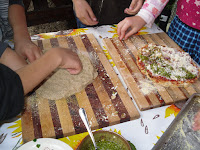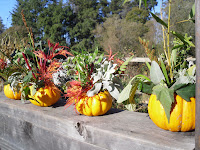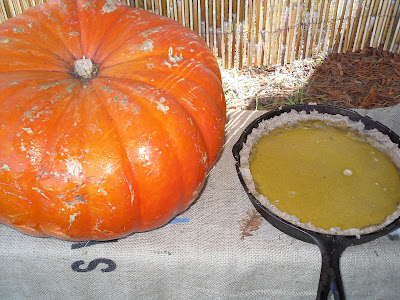The fourth graders used to seem impossibly grown-up. Now one of them is mine, and yes, they are impossibly grown up. For little kids. They are starting to learn fractions, so next week we will wrap up the loose ends of their 3rd grade farm year by threshing and grinding the wheat they planted this time last year. What does that have to do with fractions, you wonder? Well, when you thresh and grind wheat, you have flour. And when you have flour, and a cobb oven, you can make pizza. And when you cut pizza… fractions! And yes, planting wheat a year ahead of time does seem like the long way around to learn how to divide a whole into parts.

Then again, it might be a short cut to learning how to turn parts into a whole. How to turn a group of kids into a community, how to turn several bites of food into an understanding of soil enrichment (the horse manure I brought from our pony to prep the soil, real life poop in their shovels), pest management (scarecrows, amazingly effective), measurement & recording (how much rain fell into the gauge, how tall are our shoots this week), and time (in the classroom they do what-time-does-this-clock-say worksheets, the garden gives them a sense of time’s passage as they see their wheat sprout and change, watching the clock hands of their lives moving forward as the wheat and they all grow taller together). But that’s the fourth graders, and their pizza won’t be in the oven until next week.

This week it’s the third graders’ turn to plant their wheat, and to me it feels like I’ll blink and there they will be, big fourth graders, threshing and grinding. This convergence of planting and pizza have brought me to the predictable (yet always surprising) revelation that I can’t stop time, and my kids are growing older, and I can’t slow it down no matter how much I just want to keep them small enough to stay under the shield of my motherwings. “Slow down!” I want to yell, over the din of the third grade class negotiating with each other about which clothes and accessories will make the best scarecrows. (Scarecrow-making tends to be the class in which we dive headlong into intense social dynamics.)
Instead, I fall back on my usual “Walking feet please, walking feet” singsong, with which I remind them that there is a hard and fast No Running rule in the garden area (hey, we have knives and sharp tools AND slippery mud, we gotta draw the line somewhere). I am The Enforcer of such rules—“your mom is such a nurse,” they complain to my son—constantly making kids rewash their hands or return to their starting place and walk, losing their coveted place in line. They all know that I’m unlikely to cut them much slack in that way, always wishing they would slow down and stay safe.
So when my scarecrow group finishes their creation (I love these kids, because when they couldn’t decide whether it was a man or a woman and I suggested “transgendered,” they all just shrugged and said “yeah, that.”) and we are assigned to go harvest for today’s stir-fry, we all walk off across the playfield toward the beds behind the classrooms. Well, maybe there was some surreptitious skipping behind my back, but I didn’t see that; I certainly would have had to nix the joyful skipping if I’d seen it, so I kept my eyes on the purple bean vines we were heading for. Actually, we are not technically in the garden area so the No Running rule isn’t valid, but I’m not going to bring that up. Wild Child is in my group, and his feet are anxious ones, always tapping and shuffling, kicking wood chips and generally trying to escape the confines of their assigned space.
We pick half of the long eggplant-colored beans, leaving the rest for the afternoon group, then build a large pile of kale leaves on top of the bean bowl, and I let Wild Child harvest the lone tiny broccoli floret which has suddenly become the object of all his longing. The excitement of adding his own unplanned ingredient to the stir-fry is almost too much for his twitchy feet, and his wide green eyes turn up to me pleading, as we turn to head back across the wide expanse of grass to the garden. “As long as you stop at the garden gate,” I smile, taking the bowl of vegetables. And they are off, as if their feet have wings. Maybe my wings are getting too small for them already.
Autumn Harvest Stir-fry
Overheard, a monologue:
“Stir-fry! Cool, stir-fry is awesome…. Wait. No, not stir-fry. I hate stir-fry. Yuck... Wait. What is stir-fry, anyway?”
The thing about this recipe is, well, there’s no recipe. Except we had pre-boiled potatoes to add in. Other than that, you just harvest what you have, chop it up, and sauté it. Add a little Bragg’s Amino Acid spray and voila, a garden meal. The garlic makes the whole garden fragrant as it cooks, and everyone is hungry, and they love it, a big bowl of vegetables with almost nothing else, and enough for second helpings.
This time we used: garlic, leeks, purple beans, kale, a tiny piece of broccoli, and the aforementioned potatoes. Wild Child’s instructions to me on how they made the stir-fry mostly involved a meticulous description of how you actually have to touch the kale to wash it because the water alone will not get the dirt off.
 In the fall, remove the straw and cardboard and add them to your compost pile, then dig in what's left of the manure.
In the fall, remove the straw and cardboard and add them to your compost pile, then dig in what's left of the manure. Scatter heirloom wheatberries passed down to you from the previous year's class over the prepped plot. Mark the field so people will know it's not just grass.
Scatter heirloom wheatberries passed down to you from the previous year's class over the prepped plot. Mark the field so people will know it's not just grass. Watch it grow. Notice how much it shoots up when it rains. Check it at least weekly for 7 months. In the spring, see the slow toll of gophers, and the impression of the deer that thinks the wheatfield is a great place to sleep.
Watch it grow. Notice how much it shoots up when it rains. Check it at least weekly for 7 months. In the spring, see the slow toll of gophers, and the impression of the deer that thinks the wheatfield is a great place to sleep.
 Form into pizza rounds, load up with toppings...
Form into pizza rounds, load up with toppings...















